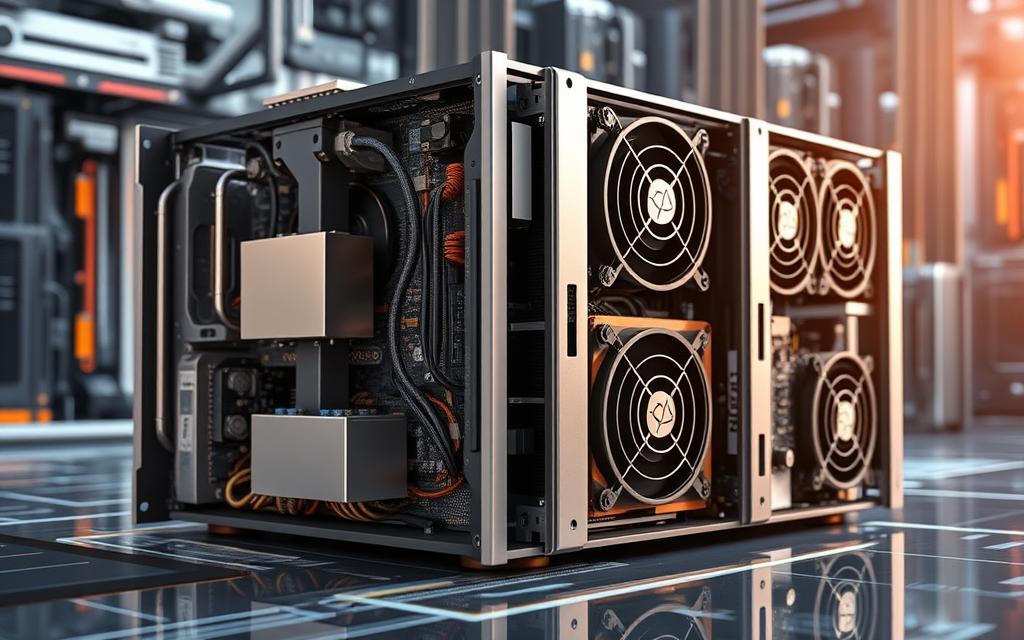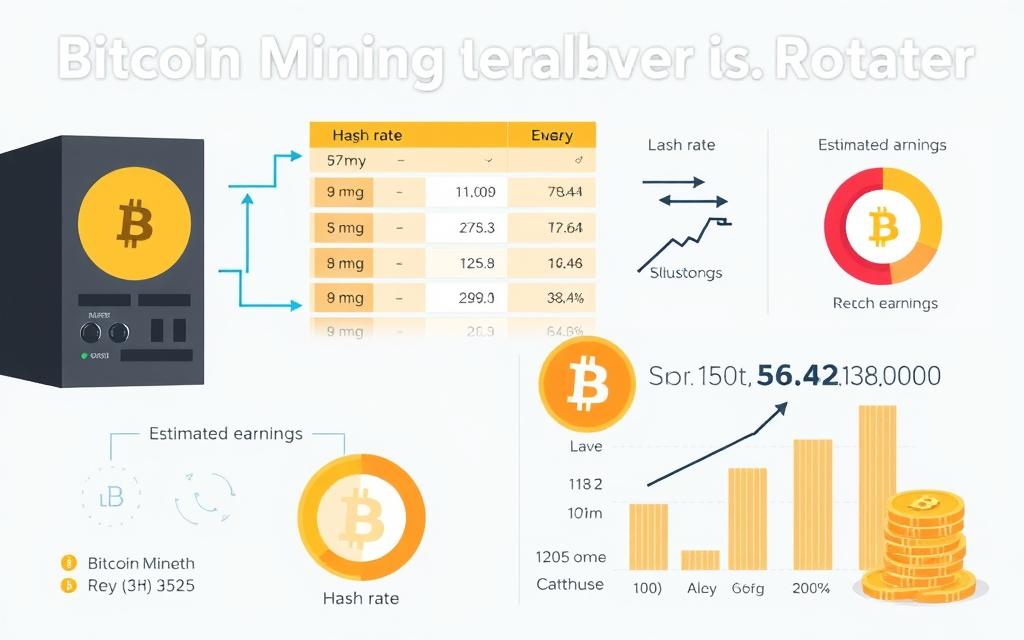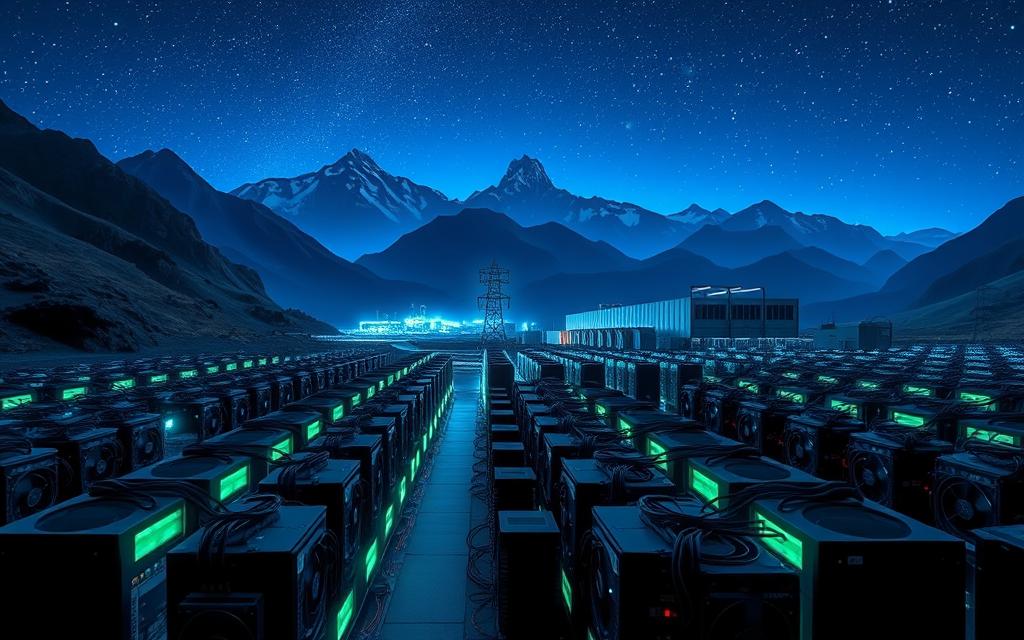Table of Contents
Bitcoin mining is a complex process that validates transactions on the network and introduces new Bitcoin into circulation. As of July 2024, approximately 19.5 million Bitcoin are in circulation, with 1.5 million yet to be mined out of a total supply of 21 million coins.
The time it takes to mine a Bitcoin depends on various factors, including the efficiency of mining equipment, network difficulty, and total computing power. Bitcoin blocks are generated every 10 minutes, but this doesn’t mean individual miners consistently mine Bitcoin in that timeframe. For more information on the factors influencing mining speed, you can visit our detailed guide on how long it takes to mine 1.
The mining process has evolved significantly, from a simple process to a sophisticated industry requiring specialized equipment. Understanding the factors that influence mining success is crucial for anyone involved in this complex process.
Understanding Bitcoin Mining
Mining is the backbone of the Bitcoin ecosystem, providing a decentralized method of transaction verification. Bitcoin mining involves using powerful computers to solve complex mathematical problems, which helps to secure the network and verify transactions.
What is Bitcoin Mining?
Bitcoin mining is the process by which new Bitcoins are entered into circulation. It involves validating transactions and creating new blocks to be added to the blockchain. Miners compete to solve a complex mathematical puzzle, with the first to solve it getting to add a new block of transactions to the blockchain.
The Role of Miners in the Bitcoin Network
Miners play a crucial role in maintaining the integrity of the Bitcoin network. They act as decentralized validators, confirming transactions without the need for a central authority. By doing so, they help build consensus about the state of the blockchain and are incentivized through block rewards and transaction fees.
- Miners verify transactions, ensuring the integrity of the network.
- They compete to solve mathematical puzzles, securing the blockchain.
- Miners are rewarded for their work, incentivizing them to continue supporting the network.
How Long Does it Take to Mine a Bitcoin?
To determine how long it takes to mine a Bitcoin, we need to consider the underlying mechanics of the Bitcoin network. The Bitcoin protocol is designed such that a new block is added to the blockchain approximately every 10 minutes.
The 10-Minute Block Time Explained
The 10-minute block time is a fundamental aspect of the Bitcoin network, ensuring that the blockchain grows at a steady and predictable rate. This interval is not a fixed time but rather an average target maintained by the network’s difficulty adjustment algorithm.

Current Block Rewards and Mining Speed
Currently, each block rewards miners with 3.125 BTC. To answer the central question, it takes an average of 10 minutes to mine 3.125 Bitcoin. The theoretical time to mine one bitcoin is approximately 3.2 minutes (10 minutes ÷ 3.125 BTC). However, this calculation is misleading for individual miners as they don’t mine fractions of a block.
| Event | Block Reward (BTC) | Year |
|---|---|---|
| Initial Reward | 50 | 2009 |
| First Halving | 25 | 2012 |
| Second Halving | 12.5 | 2016 |
| Third Halving | 6.25 | 2020 |
| Fourth Halving | 3.125 | 2024 |
The block reward has decreased over time through halving events. Transaction fees now supplement the block reward and will eventually become the primary incentive for miners, maintaining mining activity even as the block subsidy decreases.
Key Factors Affecting Bitcoin Mining Time
Multiple key factors impact the timeframe for mining a Bitcoin. Understanding these elements is crucial for miners to optimize their operations and maximize their returns.
Network Hash Rate
The network hash rate is a critical factor in determining Bitcoin mining time. It refers to the total computing power of all miners on the network. A higher network hash rate indicates a more secure network but also means that individual miners face greater competition.
The current network hash rate is a key indicator of the network’s overall security and mining difficulty. As more miners join the network, the hash rate increases, making it harder to mine Bitcoins.
Mining Difficulty Adjustments
Mining difficulty adjustments occur every 2016 blocks, or approximately every two weeks. The difficulty level is adjusted based on the network hash rate to maintain a consistent block time of around 10 minutes. A higher difficulty level means that miners need more powerful hardware to solve the complex mathematical equations required to mine Bitcoins.
Your Mining Hardware’s Hash Power
The hash power of your mining hardware directly affects your mining success rate. The higher the hash rate of your equipment, the more likely you are to mine a Bitcoin. Miners should consider both the raw computing power and energy efficiency of their hardware.
| Mining Hardware | Hash Rate (H/s) | Power Consumption (W) |
|---|---|---|
| ASIC Miner | 100,000,000 | 1500 |
| GPU Miner | 10,000,000 | 800 |
| CPU Miner | 100,000 | 100 |
Bitcoin Mining Hardware Options

To mine Bitcoin effectively, one must invest in the right mining hardware. The landscape of Bitcoin mining hardware has evolved, offering various options for miners.
ASIC Miners: The Industry Standard
Application-Specific Integrated Circuit (ASIC) miners have become the industry standard for Bitcoin mining due to their high hash rate and efficiency. These machines are designed specifically for Bitcoin mining, offering superior performance compared to other types of hardware. If you want to be competitive, you’ll need to buy several ASIC miners and join a pool, which can cost between $4,000 and $12,000 per rig.
GPUs and CPUs: Are They Still Viable?
While ASIC miners dominate the Bitcoin mining scene, Graphics Processing Units (GPUs) and Central Processing Units (CPUs) are still used for other cryptocurrencies. However, for Bitcoin, their mining power is significantly less than that of ASICs, making them less viable for profitable Bitcoin mining.
Comparing Mining Equipment Efficiency
When choosing mining equipment, it’s crucial to consider their efficiency, measured in hashes per watt. A higher efficiency means lower electricity costs and potentially higher profitability. You can check whether you can mine cryptocurrency with a home to understand the basics, but for serious mining, specialized equipment is necessary.
Solo Mining vs. Mining Pools
Bitcoin miners have two primary options for mining cryptocurrency: solo mining and joining a mining pool. The choice between these two approaches depends on several factors, including the miner’s hash power, risk tolerance, and operational scale.
The Challenges of Solo Mining
Solo mining involves mining independently without joining a pool. While solo miners keep the entire block reward if they successfully mine a block, the chances of doing so are extremely low due to the high network hash rate. Solo mining is only viable for those with significant hash power.
How Mining Pools Work
Mining pools, on the other hand, allow miners to combine their hash power, increasing their chances of solving complex mathematical equations and earning rewards. The rewards are then distributed among pool members based on their contributed hash power.
Types of Mining Pools and Their Payout Structures
There are several types of mining pools, each with its own payout structure. These include:
- Proportional (PROP) pools, which distribute rewards based on the shares contributed during the round when a block is found.
- Pay-Per-Share (PPS) pools, which offer guaranteed payments for each valid share submitted.
- Pay Per Last N Shares (PPLNS) pools, a hybrid system that balances risk and reward between pool operators and miners.
The choice of mining pool depends on a miner’s risk tolerance and operational scale. The following table summarizes the key characteristics of these pool types:
| Pool Type | Payout Structure | Risk Level |
|---|---|---|
| Proportional (PROP) | Rewards based on shares contributed | High |
| Pay-Per-Share (PPS) | Guaranteed payments per valid share | Low |
| Pay Per Last N Shares (PPLNS) | Balanced risk and reward | Medium |

The Impact of Bitcoin Halving on Mining Time
Understanding the impact of Bitcoin halving on mining time is essential for miners and investors alike. Bitcoin halving is a predetermined event that occurs approximately every four years, significantly affecting the mining ecosystem.

What is Bitcoin Halving?
Bitcoin halving refers to the reduction of the block reward by half, directly impacting the number of new Bitcoins entering circulation. This mechanism is designed to control inflation and maintain the value of Bitcoin over time.
Historical Halving Events and Their Effects
Historically, Bitcoin halving events have led to significant changes in the mining landscape. By reducing block rewards, these events have forced miners to adapt, often leading to increased consolidation and efficiency among mining operations.
Future Halvings and Mining Profitability
As we look to future halving events, it’s clear that the decreasing block rewards will continue to challenge miners. The transition towards transaction fees as a primary revenue source will be crucial for maintaining mining profitability in the long term.
Calculating Bitcoin Mining Profitability

To assess the viability of Bitcoin mining, one must delve into the intricacies of mining profitability. This involves understanding both the costs associated with mining and the revenue generated from it.
Mining Costs: Electricity, Hardware, and Infrastructure
The primary costs involved in Bitcoin mining include electricity to power the mining rigs, the hardware itself (such as ASIC miners), and infrastructure costs (like cooling systems and facility rental). Efficient management of these costs is crucial for maintaining profitability. For instance, miners often seek locations with low electricity costs to minimize expenses.
Revenue Factors: Block Rewards and Transaction Fees
Miners earn revenue through block rewards (newly minted Bitcoins) and transaction fees (fees paid by users for transaction processing). The block reward is currently the primary source of income, but as the reward halves over time, transaction fees will become increasingly important. Using a Bitcoin mining profitability calculator can help estimate potential earnings based on current network conditions.
Break-Even Analysis for Bitcoin Mining
A break-even analysis is essential for determining when a mining operation will become profitable. This involves calculating the point at which total revenue equals total costs. Factors such as the cost of hardware, electricity rates, and the current price of Bitcoin are critical in this calculation. Due to Bitcoin’s difficulty adjustment, the marginal cost of mining one Bitcoin will approach its market value, making it essential to operate efficiently.
Real-World Mining Timeframe Examples
The size and capacity of mining operations play a crucial role in determining their mining timeframe. Different scales of operations have varying efficiencies and capabilities.
Small-Scale Mining Operations
Small-scale mining operations typically involve a limited number of miners and lower power consumption. These operations might not be as efficient as larger ones but can still be profitable under the right conditions. For instance, a small operation with a few ASIC miners can mine Bitcoins, albeit at a slower rate.
Medium-Sized Mining Farms
Medium-sized mining farms represent a middle ground, with more substantial hardware and power consumption. These operations often have a more significant impact on the Bitcoin network and can adjust their strategies based on market conditions. They contribute notably to the overall hash rate.
Large Industrial Mining Operations
Large industrial mining operations control significant percentages of the Bitcoin network hash rate. These operations involve thousands of ASIC miners and consume multiple megawatts of power. They achieve economies of scale, making mining profitable even during market downturns.
| Operation Size | Number of Miners | Power Consumption | Hash Rate Contribution |
|---|---|---|---|
| Small-Scale | 1-100 | Low | Minimal |
| Medium-Sized | 100-1,000 | Moderate | Notable |
| Large Industrial | 1,000+ | High | Significant |
According to research by the University of Cambridge, the majority of Bitcoin mining operations are now centered in the United States, with over 62% concentrated in four states: Georgia, Texas, Kentucky, and New York. These large operations significantly impact the network by contributing to the overall hash rate and validating blocks.

Conclusion: Is Bitcoin Mining Worth Your Time?
Having examined the various aspects of Bitcoin mining, we now turn to the critical question: is it worth the investment of time and resources? The process of mining Bitcoin is complex and influenced by multiple factors, including network hash rate, mining difficulty adjustments, and the type of mining hardware used.
Miners must consider these elements, as well as the current block rewards and transaction fees, to determine the potential profitability of their operations. As Satoshi Nakamoto once noted, the marginal cost of Bitcoin mining tends to mirror the price of Bitcoin, suggesting that mining can be a viable venture when done efficiently.
For different types of miners, from hobbyists to institutional investors, the prospects vary. While solo mining has its challenges, joining mining pools can help mitigate uncertainty. Alternative options, such as investing in mining stocks or cloud mining services, also provide ways to gain exposure to Bitcoin mining without directly managing the process.
In conclusion, while Bitcoin mining requires significant resources and expertise, it continues to play a crucial role in maintaining the security and functionality of the Bitcoin network. As the industry evolves, understanding the risks and rewards will be essential for those considering entering the world of Bitcoin mining.
FAQ
What is the average time it takes to mine one Bitcoin?
The average time to mine one Bitcoin is related to the block reward and the network’s hash rate. Currently, it takes around 10 minutes to mine a block, and with a block reward of 6.25 BTC, the time to mine one Bitcoin is approximately 10 minutes, but this can vary based on the mining difficulty and the miner’s hash power.
How does the Bitcoin halving event affect mining time?
The Bitcoin halving event, which occurs every four years, reduces the block reward by half. This reduction doesn’t directly affect the time it takes to mine a block, which remains around 10 minutes, but it impacts mining profitability and can influence the network’s hash rate as some miners may shut down their operations if they become unprofitable.
What is the role of mining pools in Bitcoin mining?
Mining pools allow miners to combine their computing power, increasing their chances of solving complex mathematical equations and earning block rewards. By joining a mining pool, miners can receive more consistent payouts compared to solo mining, where rewards can be sporadic.
How does the network hash rate impact Bitcoin mining time?
The network hash rate is a measure of the total computing power being used to mine Bitcoins. A higher hash rate means more miners are competing to solve the mathematical equations, which can lead to a decrease in the time it takes to mine a block. However, the Bitcoin protocol adjusts the mining difficulty every 2016 blocks to maintain a consistent block time of around 10 minutes.
What is the difference between solo mining and pool mining?
Solo mining involves a miner competing alone to solve the mathematical equations required to mine a block, whereas pool mining involves a group of miners combining their resources to increase their chances of solving the equations. Pool mining provides more consistent rewards, while solo mining can result in more significant rewards but with less frequency.
How does the mining difficulty adjustment impact the time to mine a Bitcoin?
The mining difficulty adjustment occurs every 2016 blocks and is designed to maintain a consistent block time of around 10 minutes. If the network hash rate increases, the difficulty will adjust upward, making it harder to mine a block, and if the hash rate decreases, the difficulty will adjust downward, making it easier to mine a block.









